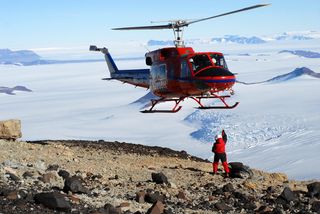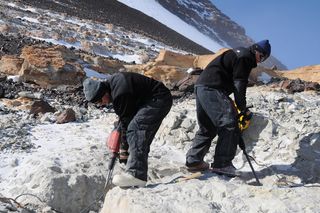Dinosaurs That Once Roamed Antarctica 'Live' Again in Exhibits and Film

WASHINGTON — Antarctica is a harsh and unforgiving place; with 99 percent of the continent covered in ice, it is the coldest and windiest spot on Earth, and few living things can survive on the continent's frozen landscape.
But nearly 200 million years ago, Antarctica was very different. There were no polar ice caps, it was far warmer and wetter than it is now, and its lush, forest environments were inhabited by a variety of animals — including dinosaurs.
Scientists dedicated to uncovering Antarctic dinosaur fossils spend months at a time camped on glaciers and digging in a frozen desert in order to excavate and reconstruct beasts that lived in the distant past. After paleontologists discover and describe Antarctic dinosaur fossils, they work closely with museum exhibit developers and artists to present the public with a glimpse of how these ancient animals might have looked and behaved, according to experts who spoke at a Future Con here on June 17. [50 Amazing Facts About Antarctica]
Finding the fossils, and then eventually bringing them to life in museum exhibitions and films, is a process that takes years and requires collaboration between researchers and artists, the panel members explained.
As harsh as present-day Antarctica may be, the excitement of discovering fossils and working and camping on the ice alongside teams of atmospheric scientists, geologists and ecologists makes it "a fun place to live — for a few months," said Future Con panelist Nathan Smith, a paleontologist at the Natural History Museum of Los Angeles County.
To find dinosaur fossils, Smith and the other paleontologists established a field camp on Beardmore Glacier and then traveled to the nearby Mount Kirkpatrick to investigate areas of exposed rock. Fossil-rich rock layers were typically found on the mountainside underneath rocky surface layers that did not contain fossils; the scientists removed surface rock in 2003 by blasting through it with explosives, Smith said.

In 2010, Smith and his colleagues identified a new dinosaur species that is yet to be described, he told the panel's audience. The paleontologists discovered densely packed fossils belonging to a type of early sauropod — a long-necked and long-tailed plant-eating dinosaur — including vertebrae, ribs, arm and leg bones, and an intact skull. Sauropod skulls are extremely delicate and rarely fossilized in one piece, and this rare find allowed scientists to scan the skull using computed X-ray tomography (CT) and construct 3D models, visualizing the skull inside and out, Smith explained.
Sign up for the Live Science daily newsletter now
Get the world’s most fascinating discoveries delivered straight to your inbox.
Displaying dinosaurs
To share exciting finds like these with the public, experts at The Field Museum in Chicago are developing an exhibit to showcase the dinosaurs that once populated Antarctica, Tom Skwerski, director of exhibition operations at The Field Museum, said at the Future Con panel. But to do that, exhibit designers had to overturn their own misconceptions about that ancient world and its inhabitants.
"The first logo was a T. rex in a parka," Skwerski said. "I realized we had a lot of work to do to convey what the exhibit is about."
Whereas modern-day Antarctica is blanketed by ice and snow, the landscape was covered in lush forests when dinos roamed the land. The exhibit needed to connect visitors to both of those worlds, Skwerski said. Visual effects that recall the auroral displays of the southern lights will accompany immersive soundscapes, to create an exhibit environment that transports visitors back to Antarctica as it appeared hundreds of millions of years ago, he said.
The exhibit also addresses the physical challenges, both recent and historical, of conducting scientific work in Antarctica. In an introductory section in the exhibit, a computer interactive offers users the opportunity to select expedition gear from a modern list or from what was available to early-20th-century explorers. Other exhibit highlights include a skeleton and a reconstruction of the carnivorous Antarctic dinosaur Cryolophosaurus ellioti, as well as dioramas showing early sauropods, Skwerski said. [Extreme Living: Scientists at the End of the Earth]
Dinosaurs on film
After the fossils are discovered and the exhibits have debuted, work begins on the animated movies that bring those extinct animals "back to life," panelist David Clark, a producer who has created films for National Geographic and IMAX, said at Future Con.

Clark's upcoming film on Antarctic dinosaurs will go one step further than the exhibit reconstruction of C. ellioti from the skeleton; it will show active dinosaurs going about their lives against the backdrop of an Antarctic forest, Clark said.
To create that illusion, filmmakers first build storyboards — sequences of drawings that illustrate the dinosaurs' actions and the camera positions in every shot. Next, they identify locations that closely resemble the world of the ancient dinosaurs, and shoot "backplates" — backdrop footage for their animated dinosaurs, which are added during postproduction. Teams of animators build 3D computer models of dinosaurs that are then composited against the backplates, Clark explained.
In the 2007 IMAX film "Dinosaurs Alive!", which Clark directed, about 100 digital artists worked to create the movie's dinosaurs and to make them move realistically through their habitats. The process took eight months and required more than 100,000 hours of computer rendering time, Clark said.
No one can say for sure how extinct animals like dinosaurs moved, but scientists who study locomotion and biomechanics can analyze fossils and build computer models of muscle groups to estimate a dinosaur's range of motion, collaborating with animators who can visualize the dinosaurs' bodies complete with colors and textures, Clark said.
Researchers and animators also look to living animals, which can hint at how their extinct relatives might have walked or run. However, that process of comparison is somewhat easier when re-creating extinct mammals; for example, "dire wolves no longer exist, but gray wolves do," Clark said.
"It's a challenge," he added. "A lot of it is conjecture, but we try to be as realistic as we can."
Original article on Live Science.

Mindy Weisberger is an editor at Scholastic and a former Live Science channel editor and senior writer. She has reported on general science, covering climate change, paleontology, biology, and space. Mindy studied film at Columbia University; prior to Live Science she produced, wrote and directed media for the American Museum of Natural History in New York City. Her videos about dinosaurs, astrophysics, biodiversity and evolution appear in museums and science centers worldwide, earning awards such as the CINE Golden Eagle and the Communicator Award of Excellence. Her writing has also appeared in Scientific American, The Washington Post and How It Works Magazine.

